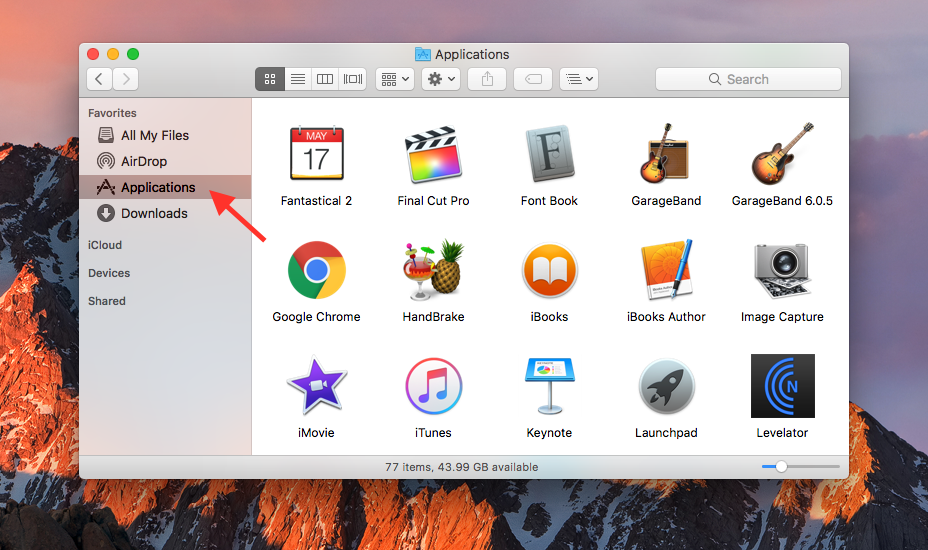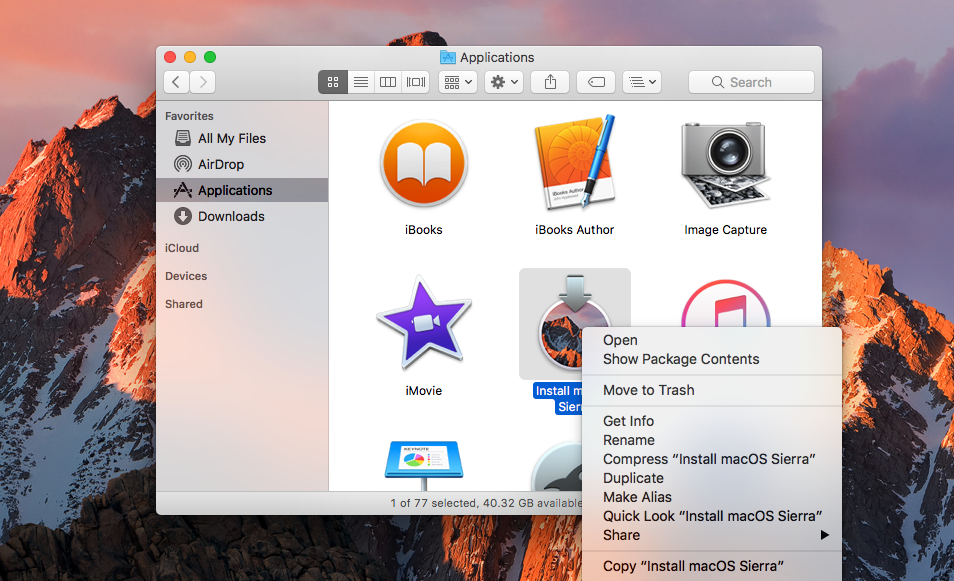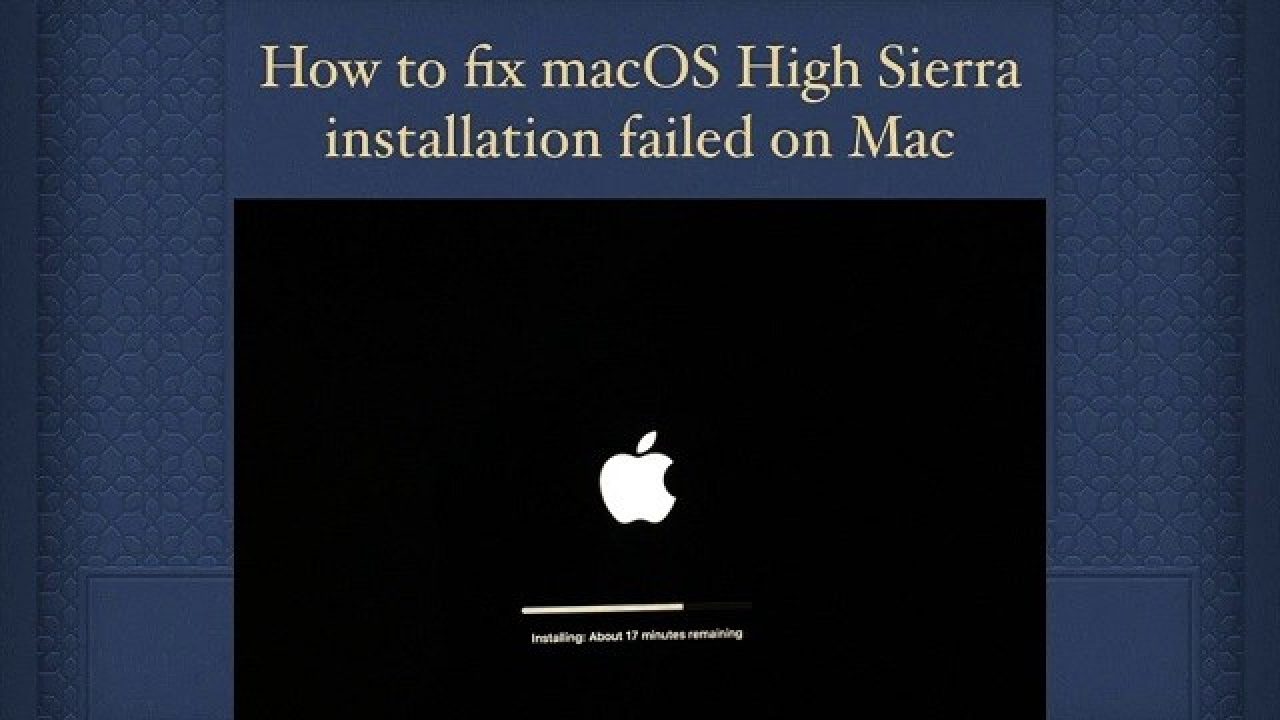Look for an application called Install macOS Sierra. And click Quit Install macOS to close the app. Now you can repeat the step above if needed. Your Mac can delete the macOS installer on. I suppose the Applications DVD is worthless since all of that stuff is free on the App Store. I'll keep that SL disc for a long time though. You can edit those and use them on any Mac that can accept the OS, regardless of whether or not it is the exact computer that shipped with it.
To get the latest features and maintain the security, stability, compatibility, and performance of your Mac, it's important to keep your software up to date. Apple recommends that you always use the latest macOS that is compatible with your Mac.
Learn how to upgrade to macOS Big Sur, the latest version of macOS.
Apple has simplified the app installation and update process in OS X, but sometimes you need to see more information about exactly when and how the software on your Mac was installed. I am unable to successful install office 365 on my mac. My mac runs OS Sierra 10.12.6. (I have installed it successfully on my other mac running Mojave) After being prompted to enter my Microsoft username, it never progresses to asking me for the passward. I’m not inclined to free up 13GB now, and probably never, so can I safely delete the “Install macOS Big Sur.app” from the Applications folder? Will that also stop the installation alert that I continue to get, and will it get rid of the annoying red dot on the System Preferences icon in the dock?

Check compatibility
If a macOS installer can't be used on your Mac, the installer will let you know. For example, it might say that it's too old to be opened on this version of macOS, or that your Mac doesn't have enough free storage space for the installation.
To confirm compatibility before downloading, check the minimum requirements for macOS Catalina, Mojave, High Sierra, Sierra, El Capitan, or Yosemite. You can also find compatibility information on the product-ID page for MacBook Pro, MacBook Air, MacBook, iMac, Mac mini, or Mac Pro.
Make a backup
Before installing, it’s a good idea to back up your Mac. Time Machine makes it simple, and other backup methods are also available. Learn how to back up your Mac.
Download macOS
It takes time to download and install macOS, so make sure that you're plugged into AC power and have a reliable internet connection.
Safari uses these links to find the old installers in the App Store. After downloading from the App Store, the installer opens automatically.
- macOS Catalina 10.15 can upgrade Mojave, High Sierra, Sierra, El Capitan, Yosemite, Mavericks
- macOS Mojave 10.14 can upgrade High Sierra, Sierra, El Capitan, Yosemite, Mavericks, Mountain Lion
- macOS High Sierra 10.13 can upgrade Sierra, El Capitan, Yosemite, Mavericks, Mountain Lion
Safari downloads the following older installers as a disk image named InstallOS.dmg or InstallMacOSX.dmg. Open the disk image, then open the .pkg installer inside the disk image. It installs an app named Install [Version Name]. Open that app from your Applications folder to begin installing the operating system.
- macOS Sierra 10.12 can upgrade El Capitan, Yosemite, Mavericks, Mountain Lion, or Lion
- OS X El Capitan 10.11 can upgrade Yosemite, Mavericks, Mountain Lion, Lion, or Snow Leopard
- OS X Yosemite 10.10can upgrade Mavericks, Mountain Lion, Lion, or Snow Leopard
Install macOS
Follow the onscreen instructions in the installer. It might be easiest to begin installation in the evening so that it can complete overnight, if needed.
If the installer asks for permission to install a helper tool, enter the administrator name and password that you use to log in to your Mac, then click Add Helper.
Please allow installation to complete without putting your Mac to sleep or closing its lid. Your Mac might restart, show a progress bar, or show a blank screen several times as it installs macOS and related firmware updates.

Learn more
You might also be able to use macOS Recovery to reinstall the macOS you're using now, upgrade to the latest compatible macOS, or install the macOS that came with your Mac.
Make your Mac invincible
Normally when you install a new version of macOS, you just install it over the previous version. It’s quick, easy and means we can be back up and running in no time, with all your apps and data ready to use. Your data remains but your software and file junk remains as well.
That’s why, sometimes, it makes more sense to run a clean install. Whether it’s because your Mac has accumulated so many junk files that it’s performance is badly affected or because you’re passing your Mac onto someone else and want to make sure all your data is removed. Or maybe you just want that fresh out of the box Mac experience again. Whatever your reasons, here is how to clean install macOS High Sierra.
How to prepare your Mac for the clean install
Before you do anything, check that your Mac is able to run Apple's new operating system.
To complete the clean install procedure described below, you'll need:
- macOS High Sierra Installer,available from the Mac App Store.
- a 16GB or larger USB flash drive
Notice: USB drive is needed for a clean install on your Mac’s startup drive. If you plan to clean install macOS on a non-startup drive, you don't need it. - go for a system cleanup and backup your data - this will allow you to easily return your Mac to the condition it was in before you installed macOS.
- and an hour or two to spare.
Choose the right way to clean install macOS High Sierra
Before you proceed, you need to make a choice how to run a clean install. If you only have one drive and it’s not partitioned and this is where you have all your files and your OS, your choice is to clean install on the startup drive. This way entails one important fact: all your files and data will be deleted during the process.

If you have another drive or volume other than your startup drive, use the second way which is clean installing on a non-startup drive. It’s a more lenient and less intrusive way because your Mac doesn’t get wiped clean, only your system.
If you don’t know which one you have, go with the first option, startup drive.
How to clean install macOS on a startup drive
Once you have everything that's needed, let's begin. Don’t worry, this step-by-step guide will walk you through all you need to do.
You don't need to dig through Internet to search and and download each apps mentioned below, all of them available on Setapp. With Setapp, you always have the latest full version of every app. Cancel anytime. Signup to try Setapp for free.
The process of performing a clean install involves wiping your Mac’s main drive clean so it’s essential that you back it up immediately before you start. You might not want to backup the files you don’t need and system junk, so make sure to clean that up beforehand. An easy way to go about this is to get a Mac cleaning app like CleanMyMac. It will save to hours of manual file cleanup and polish your system before the backup.
Start with a system cleanup
Delete everything you don't need - large and old files and archives, useless apps, cache data and other junk, duplicate files - all these files silently eat up the disk space, duplicate images are especially hard to find out.
You can always use CleanMyMac to cleanup macOS system junk, large and old files, and remove unwanted apps. You could do it manually, but CleanMyMac only all it takes is a few clicks.
Then you can use Gemini to easily find duplicate files and folders on your hard drive, so you can delete them and save precious storage space.
Backup your data
Now, for the backup itself use Get Backup Pro. It’s more powerful than Apple’s own Time Machine. It’s also a good idea to create a bootable clone, so if anything goes wrong you can go back to where you started easily. Also, a cloned drive makes copying files back to your newly-updated system very easy. And move your images and documents into the cloud or to an external drive, just to be on the safe side.
As well as backing up your Mac, you should also take screenshots of settings in any apps you’ve customized so that you can set them up again quickly later. And make sure you have a record of license codes for apps and passwords for websites.
Clean install macOS, securely
Your Mac deserves a fresh start. Get the right tools for clean installing Apple's operating system.
Create a bootable macOS installer
- Download macOS High Sierra from the App Store. Here is a link to find it on apple.com.
- When it’s finished, the installer will launch. As soon as it does, select File and Quit (or keyboard shortcut Command-Q) so it doesn’t install. The installer will remain in your Applications folder.
- Plug in the USB stick and launch Disk Utilities.
It’s a good idea to use a USB stick to put the bootable installer onto. It will need to be at least 8GB in size. - Click the Erase tab and make sure Mac OS Extended (Journaled) is selected in the format tab.
- Give the USB stick a name, then click Erase.
- When it’s finished, click Done and close Disk Utility.
- Launch Terminal either by searching for it in Spotlight or navigating to the Utilities folder in Applications.
- Type, or paste, the following command into Terminal, where [YOUR DRIVE NAME] is the name you gave the installer drive when you formatted it:
sudo /Applications/Install macOS High Sierra.app/Contents/Resources/createinstallmedia --volume /Volumes/[YOUR DRIVE NAME] --applicationpath /Applications/Install macOS High Sierra.app
Notice: Remember to replace [YOUR DRIVE NAME] with the name of your installer disk. - Hit Return.
- Type in your admin password and wait.
- When the process is finished, the word Done will appear in the Terminal window.
- You can then quit Terminal
Install macOS on your startup disk drive
Make sure you backup your Mac to keep your important files, before taking next step, that erase your Mac’s Startup drive.
To erase your Mac’s main drive:

- Go to System Preferences
- Сlick Startup disk and choose the installer you just created.
- Restart your Mac and hold down Command-R to boot into recovery mode.
- Take your bootable USB and connect it to your Mac.
When the macOS Utilities screen appears, follow these steps:
- Select Reinstall a new copy of macOS.
- Click Continue, then click Continue again when the next window appears.
- Agree to the terms and conditions, then select your Mac’s internal drive.
- Click Install.
- Wait for macOS High Sierra to install and your Mac to restart.
When your Mac has restarted, you’ll need to follow the process of setting it up as if it was a brand new Mac. So, you’ll need to connect to your wifi router and type in the password. Then you’ll need to type in the details for your iCloud account. Then you’ll have to set up a new admin user account.
Once you’ve done that, you can start installing apps. In order to re-install Setapp apps, go to setapp.com to get Setapp installer or download Setapp here. You’ll need your username and password.
It’s a good idea to only download those apps you need to use straight away. Other apps can be downloaded as and when you need them. That way you avoid cluttering up your brand new macOS.
If you use a cloud service like Dropbox, now is the time to re-connect. And you can copy any documents, photos or other files you need from the backup you made at the start.
Find more information about Apple Mac update
Clean Install macOS High Sierra on a non-startup drive
You don’t need a backup for this option, it’s safer and faster than the previous way but only available to you if you have an extra drive or your drive is broken down into volumes.
Here’s how to instal your new macOS on the non-startup disk.
Step 1. Erase your non-startup drive
Can I Delete Install Mac Os Sierra App Store
Before you install the new OS on it, you need to erase all data on the drive you’ve chosen for it. To do it, use Disk Utility. Choose the volume you’d like to clean up and click Erase.
If you still need some info from that drive, you can use an app like ChronoSync Express to sync it with another drive and keep the files.
Step 2. Download the macOS High Sierra Installer from the Mac App Store
To download it, open the Mac App Store and go to the Updates tab (Here is a link.) When your installer is downloaded it will launch automatically but you need to quit it.
Fortunately, for this option you don’t need to create a specific bootable drive and you can simply use the installer from your startup drive and install the macOS onto the other one.
Step 3. Install macOS High Sierra to your non-startup drive
Launch the Installer from the Applications folder and press Continue. Change the target drive for installation. macOS will offer you startup drive by default so you need to click Show All Disks button and choose your non-startup disk volume. From then on simply follow the installation guide and after that you’ll have to set up your Mac as a new one. That entails creating a new user account, setting up date and time zone etc.
Now that you have the latest macOS, you can enjoy its superior features and top performance. Clean install (when performed on a startup drive) does remove your apps so if you don’t feel like looking for every app and their licenses again, get Setapp. More than 100 apps in one suite available by subscription. Saves you time and money on looking for apps for your daily tasks.